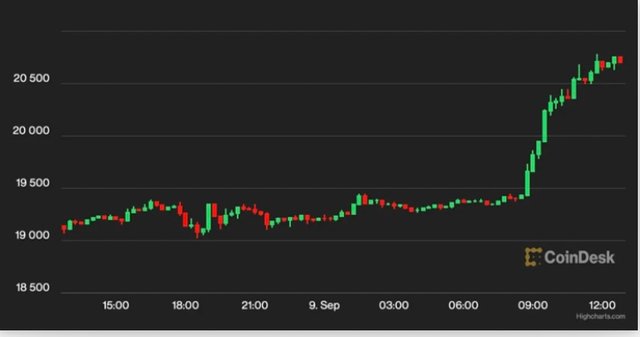Bitcoin Tops $20K as Inflation Expectations Slide, Hopes For 2023 Rate Cut Persist

Major cryptocurrencies bounced early Friday as traditional market investors shrugged off Federal Reserve Chairman Jerome Powell's pro-liquidity tightening stance.
Perhaps risk assets, including cryptocurrencies, drew strength from sliding inflation expectations and prospects of renewed monetary easing next year.
Bitcoin, the leading cryptocurrency by market value, jumped 7% to $20,600 and ether, the native token of Ethereum's blockchain, scheduled to undergo a major technological upgrade next week, rose 4% to $1,705, according to CoinDesk data.
MSCI's broadest index of Asia-Pacific shares except Japan jumped 0.3%. The futures tied to the S&P 500 rose 0.3%, hinting at an extension of a two-day rally, while the European stock futures signaled a positive open. The dollar index dropped 0.7% to 108.80, signaling continued weakness in the greenback.
At a think tank conference Thursday, Powell said, "we need to act right now – forthrightly, strongly," reiterating his commitment to fighting inflation with rapid-fire interest rate hikes. This year, the so-called policy tightening has roiled risk assets, including cryptocurrencies.
However, forward-looking markets focused on leading indicators that signaled the stubbornly high pandemic-era inflation would cool in the coming months, weakening the case for a continued rapid-fire Fed tightening.
Global container freight rates slipped to 16-month lows early this week, nearly halving from their 2021 peak in a sign of easing supply chain issues.
The Fed has raised rates by 225 basis points (bps) this year and has begun reducing the size of its balance sheet at a monthly pace of $95 billion from this month. The Fed fund futures showed that the central bank would raise rates by 50 bps in November and 25 bps in December, ending the year with the benchmark interest rate in the range of 3.75% to 4%.
"The bounce is not surprising," Ardern said. "Aside from lead indicators signaling lower inflation, the European Central Bank's decision to hike rates by 75 basis points on Thursday has eliminated a major uncertainty from the market."
Freight rates jumped nearly ten-fold last year as the coronavirus pandemic created supply chain problems. That added to the core inflation, which strips out the volatile energy and food component. Powell on Thursday said high inflation was mainly due to coronavirus.
CoinDesk - UnknownThe supply chain pressure index has tumbled from its highs, hinting at slowdown in inflation in the coming months. (Ophir Gottlieb, Capital Market Laboratories)
Freight rates jumped nearly ten-fold last year as the coronavirus pandemic created supply chain problems. That added to the core inflation, which strips out the volatile energy and food component. Powell on Thursday said high inflation was mainly due to coronavirus.
The U.S. one-year breakeven inflation rate, a market-based measure of expected price pressures over the next 12 months, fell below the Fed's 2% target.
"We are currently pencilling in a rate cut in June with further easing through the second half of 2023," James Knightley, chief international economist at ING., wrote in a market update.
"With recessionary forces intensifying, we expect inflation to fall relatively swiftly next year thanks to lower gasoline prices feeding through more broadly, weaker wage pressures and declining input costs combined with falling house prices depressing the rental components of consumer price inflation," Knightley added.
The Fed has raised rates by 225 basis points (bps) this year and has begun reducing the size of its balance sheet at a monthly pace of $95 billion from this month. The Fed fund futures showed that the central bank would raise rates by 50 bps in November and 25 bps in December, ending the year with the benchmark interest rate in the range of 3.75% to 4%.